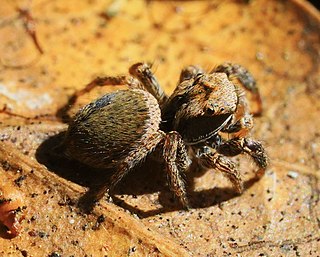
Jumping spiders are a group of spiders that constitute the family Salticidae. As of 2019, this family contained over 600 described genera and over 6,000 described species, making it the largest family of spiders at 13% of all species. Jumping spiders have some of the best vision among arthropods and use it in courtship, hunting, and navigation. Although they normally move unobtrusively and fairly slowly, most species are capable of very agile jumps, notably when hunting, but sometimes in response to sudden threats or crossing long gaps. Both their book lungs and tracheal system are well-developed, and they use both systems. Jumping spiders are generally recognized by their eye pattern. All jumping spiders have four pairs of eyes, with the anterior median pair being particularly large.

Peckhamia is a genus of ant-mimicking jumping spiders that was first described by Eugène Louis Simon in 1900. It is named in honor of George and Elizabeth Peckham, and is considered a senior synonym of the genus Consingis.

Habronattus signatus is a species of jumping spider in the family Salticidae. It is found in the United States and Mexico.
Habronattus schlingeri is a species of jumping spider in the family Salticidae. It is found in the United States and Mexico.
Habronattus notialis is a species of jumping spider in the family Salticidae. It is found in the United States.

Habronattus orbus is a species of jumping spider in the family Salticidae. It is found in the United States.

Habronattus texanus is a species of jumping spider in the family Salticidae. It is found in the United States and Mexico.

Habronattus pugillis is a species of jumping spider in the family Salticidae. It is found in the United States and Mexico.

Habronattus tarsalis is a species of jumping spider in the family Salticidae. It is found in the United States and has been introduced into Hawaii.

Habronattus conjunctus is a species of jumping spider in the family Salticidae. It is found in the United States and Mexico.

Habronattus carolinensis is a species of jumping spider in the family Salticidae. It is found in the United States and Canada?.
Habronattus captiosus is a species of jumping spider in the family Salticidae. It is found in the United States and Canada.
Habronattus ocala, the ocala jumper, is a species of jumping spider in the family Salticidae. It is found in the United States.

Habronattus formosus is a species of jumping spider in the family Salticidae. It is found in the United States.

Habronattus brunneus is a species of jumping spider in the family Salticidae. It was discovered by George and Elizabeth Peckham in 1901. It is found in the United States and in the Caribbean, where it has been recorded from the Bahamas, the Dominican Republic, Haiti, Hispaniola Island, and the Virgin Islands.
Habronattus cuspidatus is a species of jumping spider in the family Salticidae. It is found in the United States and Canada.

Habronattus oregonensis is a species of jumping spider in the family Salticidae. It is found in North America.
Habronattus sansoni is a species of jumping spider in the family Salticidae. It is found in the United States and Canada.
Habronattus forticulus is a species of jumping spider in the family Salticidae. It is found in the United States and Mexico.

Habronattus tranquillus is a species of jumping spider in the family Salticidae. It is found in the United States and Mexico.












